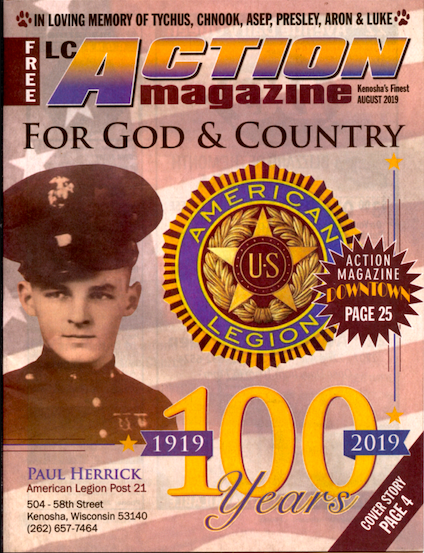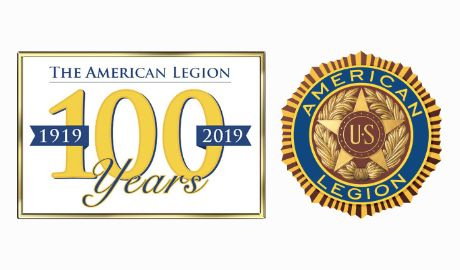A Century of Service – American Legion Post 21, Kenosha WI

One hundred years ago this November 11, will mark the end of the first great global conflict. The war to end all wars they called it, but sadly in twenty years the world would be at war once more. In those final days in France, the men of the Allied Expeditionary force developed an idea that this November will see its century anniversary. That idea became the American Legion and Kenosha post 21 is one of its original posts.
In 1938, the citizens of Kenosha came together and built a hall located at 504 58th Street as a gift to honor their fathers who service in that Great War. Little did they know at the dedication of the building, the post would become home for their sons who would be called upon to fight the next great war in just three years.
Post 21 is named after Paul Herrick, one of those young Kenosha son who enlisted in the Marine Corps only to surrender his life in service on December 7, 1941, on board the USS Arizona. Another one of those young Americans would serve in the United States Navy as a P.T. boat commander, and then as a United States Senator, his name was Kennedy. When Senator John F. Kennedy, began his run for the White House he stopped in Kenosha to address the public from our hall. In that year he was running for the Democratic Party nomination for the President of the United States. Post 21 was the location for the American legion National Convention. Form our small mid-west city, Kennedy was able to address veterans from all the states of our nation who went home to report to their local post. We still have the microphone that Kennedy used to address the delegates that day.
World War Two was the first American conflict where large numbers of Woman were able to serve. One of those Kenosha daughters was Betty Gold who enlisted to serve in the Women’s Army Auxiliary Corps, (WAAC.) She called our post home and in the next military conflict, The Vietnam War, in 1969.Legionnear Gold was the Commander of the post. She was one of the first women to be a post commander in our state.
At the apex over 1,000 veterans were members of the post. Today, we are still one of the largest in Wisconsin with just over 300 members who served from World War Two to Operation Iraqi Freedom/Operation Enduring Freedom. Eighty percent of our post served in the Vietnam War. Our longest service member was Loyd Zeltinger, who was an American Legion Post 21 member for over 70 years before he passed.
The post is active in Veteran and civic events and programs that promote the four pillars of the American Legion’s charter which was approved by the United States Congress one hundred years ago. These pillars are the heart of the American Legion. The pillars are Veterans Affairs and Rehabilitation, National Security, Americanism, and Children and Youth.
Pillar I, Veterans Affairs and Rehabilitation, The American Legion fight to improve the Veterans Affairs Administration and service for veterans returning from active duty. Service like the Employment Assistance Act originally passed to help World War Two veterans returning home. Today this law employs Local Veterans Employment representatives (LVER) and Disabled Veterans Outreach Program specialist (DVOP) in all state to helps veterans who served honorably find employment after service. Other programs like Camp America Legion here in Wisconsin is a retreat in Lake Tomahawk where veterans who are coping with PTSD or any other condition can find a retreat from their daily condition.
Pillar II, National Security, the American Legion has many programs to support not only the service member but their family. Programs like Operation Comfort Warriors and Blue Star Banners are just some of the programs that provide support to the family of active duty service member while they are deployed away from home.
Pillar III, Americanism, post 21 each years covers the cost to send 8 to 10 boys and our auxiliary sends a comparable number of girls to Badger State where that learn about how all level of state government and how government works. Past Wisconsin Governor Scott Walker, in high school was a badger boy and former President Bill Clinton attend his boys’ state in Arkansas and they was selected to attend Boys Nation while a high school junior. Attending Badger State will opens up several college scholarships for those who are selected to attend by their high school guidance counselors.
Pillar IV, Children and youth, The American Legion with programs like. Family Support Network and the Child Welfare Foundation help families with young children shoulder the added burden and cost that come when a family schedule is altered do to a military deployment or active duty call up. These programs help cover the cost of items like child care when a single parent must now juggle the family without the deployed service member help. When you see your American Legion Post 21 members out in the community providing a honor guard at events or conducting other activities, remember our service to the nation and community has not concluded upon conclusions of our military service. American Legion Post 21 and its members has served our nation for 100 years and we are still serving our community, state and nation today. Membership in our post is not limited to honorably discharged veterans. The Auxiliary and Sons are open to non-veterans who want to serve in honor of their Veteran family member(s). If want to learn more about your American Legion Post 21 or want to join the Post, Auxiliary, Sons or American Legion Riders stop in the hall or sent us a message on Facebook. Kenosha, we are proud to serve you!
Carl A. Bogar, Jr.
Past Post Commander,
Post 21 Historian
Editors Note: This article was reprinted from LC Action Magazine, August 2019. Used with Permission.






